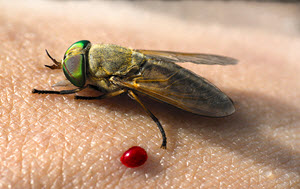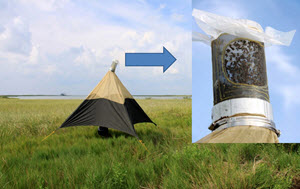
A greenhead horse fly partakes in a blood meal. (Photo by Claudia Husseneder)
Greenhead horse fly larvae live in Spartina marshes and are the top predator in the coastal wetlands invertebrate food chain between Texas and Nova Scotia.
Drs. Lane Foil and Claudia Husseneder discovered reduced genetic variation and severe declines in adult and larval horse fly populations living in oiled marshes, which showed that the horse flies could be an indicator species for post oil spill marsh health.
The Gulf of Mexico Research Initiative recently awarded Foil and Husseneder a grant to build on their previous research and develop a reliable, cost-efficient tool for measuring marsh health using this horse fly. Foil and Husseneder began researching the abundance and genetic diversity of horse fly populations in oiled and unoiled Louisiana Spartina marshes in 2010. They will use historical and current samples of adult horse flies, their larvae, and the surrounding marsh soil to determine if adult horse fly populations have recovered and how their larval food web can be used to assess marsh health.

(Click to enlarge) The researchers sampled horse flies in oiled (Jefferson and Plaquemines Parishes) and unoiled (Cameron and St. Mary Parish) areas. (Provided by Lane Foil and Claudia Husseneder)
The researchers will use metagenomic sequencing to describe the invertebrate food web in soil samples and horse fly larvae stomach contents collected from oiled and unoiled marshes. Data will reveal the groups of organisms and level of diversity that the larvae need for healthy growth and development and if oiling alters the presence of their prey. The team will then develop a tool that uses polymerase chain reaction (PCR) – a technology that generates copies of a certain DNA region until it is prevalent enough to be detectable – to search certain genetic markers in soil and determine if the taxa needed for a healthy food web are present or absent.
“The species that we picked is native and tightly bound to the marsh,” said Husseneder. “If everything that the larvae need to develop is present, then we can assume the marsh is healthy enough to support this top-level predator. If not, then the marsh is likely compromised.”

Horse flies are collected using traps like this one located in Grand Bayou, Louisiana. (Photo by Claudia Husseneder)
Larval sample collection and genomic sequencing are expensive and time-consuming. The project’s PCR tool will offer a timely, cost-efficient, and easy alternative that scientists and citizens with access to a high-school-level molecular laboratory can use to screen soil samples and assess marsh health. The tool could also be expanded to include and apply data from studies of different species in different habitats.
Foil commented, “We have a specialty area that we are contributing to a much larger area of science. I believe the tools we are developing will be very important in helping other scientists and that what we learn from them will help us better adapt our tools. As we and other researchers make our information available, we can start to put together the big puzzle of what actually happened in the marsh.”
The project’s researchers are Lane Foil and Claudia Husseneder at the Louisiana State University Agricultural Center. Their project is A Study of Horse Fly (Tabanidae) Populations and Their Food Web Dynamics as Indicators of the Effects of Environmental Stress on Coastal Marsh Health.
************
The Gulf of Mexico Research Initiative (GoMRI) is a 10-year independent research program established to study the effect, and the potential associated impact, of hydrocarbon releases on the environment and public health, as well as to develop improved spill mitigation, oil detection, characterization and remediation technologies. An independent and academic 20-member Research Board makes the funding and research direction decisions to ensure the intellectual quality, effectiveness and academic independence of the GoMRI research. All research data, findings and publications will be made publicly available. The program was established through a $500 million financial commitment from BP. For more information, visit http://gulfresearchinitiative.org/.
